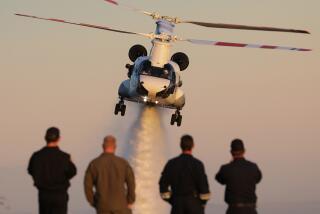Santa Clarita / Antelope Valley : 2 Super Scoopers Demonstrate Their Firefighting Prowess : Castaic: County officials watch first test of the Canadian planes, which can carry 1,400 gallons of water apiece.
- Share via
Like giant dragonflies, they alighted Tuesday on the placid blue waters of Castaic Lake, scooped up 1,400 gallons apiece and dumped a cascade of water on a designated hillside with surgical precision.
Under ideal conditions--light winds and calm water--the first local test of the Super Scooper firefighting planes unfolded like an aerial ballet against the amphitheater of bone-dry hills. The two planes swooped and pirouetted before an audience of firefighters and journalists, finishing each maneuver in under two minutes.
The newest tools in Los Angeles County’s firefighting arsenal performed so well, in fact, that firefighters were reduced to trading jests for entertainment once the initial drama wore off.
A red-faced fire captain stamped out one false report that had gone out over the two-way radio linking firefighters at the test scene: The bright yellow-and-red tanker planes did not soak the inside of his pickup truck with the equivalent of 140 bathtubs of water sucked from the lake.
“They just wet the top of the truck,” Los Angeles County Fire Capt. Frank Wall protested over the radio, squelching previous reports that he had neglected to close his truck windows.
And, although one of the Canadair CL-215Ts dumped a huge plume of water suspiciously nearby, journalists who were watching from a knoll above the lake stayed completely dry during the two-hour operation.
Still, a high-ranking county fire official couldn’t resist announcing, “REPORTERS ALL WET,” in a parody of a news headline that was perhaps wishful thinking.
Fire officials were in a jovial mood because this week’s tests are the last step in the long campaign to bring the highly touted planes to Los Angeles County. Unlike other tanker planes and the majority of helicopters that must be loaded by ground crews, the Super Scooper can swoop down on a lake or the ocean and skim across the surface at about 100 m.p.h. with intake nozzles open, taking on seven tons of water in under 12 seconds. The short turnaround between reloading and water-bombing runs improves the chances of quickly controlling or dousing a fire.
Although brief tests of the plane were conducted in Los Angeles County more than a decade ago, opponents managed to block further testing by arguing that the Super Scooper had significant drawbacks, including its purchase price--$16.5 million--and the fact that it cannot fly at night or in extremely gusty winds and cannot get refills from a choppy ocean.
But last year’s devastating fire season gave local homeowner associations and other supporters the boost they needed to add the plane to the county Fire Department’s arsenal.
With the help of a $500,000 grant from the federal government and a $157,000 donation from California’s insurance industry, the county will lease one plane for a maximum of three months from the Quebec government for about $719,000, plus $515 for every hour it is in the air. The lease includes the services of 12 pilots and mechanics.
The other plane is being donated for county use for three months by Canadair’s parent company, Bombardier Inc. of Montreal, which hopes to eventually sell Super Scoopers to the county and other California jurisdictions.
The planes will be used throughout the county, not just in the unincorporated areas that are the responsibility of county firefighters. They will be tested today at Bonelli Park in San Dimas and be ready to go to work Thursday.
The tests are being conducted primarily to familiarize ground crews with the planes, which hold more than three times the amount of water carried by the county’s firefighting helicopters. Although the Super Scooper has been used successfully for years in Quebec, many fires there occur in remote areas where the planes can release their loads without injuring firefighters, officials said.
“The size of the drop is something that’s on our minds,” said Mike Aplanalp, a county fire suppression aide. “I got hit by a load from a helicopter once and it felt like a pretty good size ocean wave.”
Tuesday, the planes made 14 runs without incident, dropping the water at various speeds and altitudes near 80 firefighters perched on a nearby slope.
Officials are also concerned about air traffic safety during fires because the Super Scoopers will share the skies with firefighting helicopters and other tanker planes.
“There’ll be a lot of iron in the sky,” said county Fire Chief P. Michael Freeman, who observed Tuesday’s test. “But I’m confident that the performance is there.”
More to Read
Sign up for Essential California
The most important California stories and recommendations in your inbox every morning.
You may occasionally receive promotional content from the Los Angeles Times.










